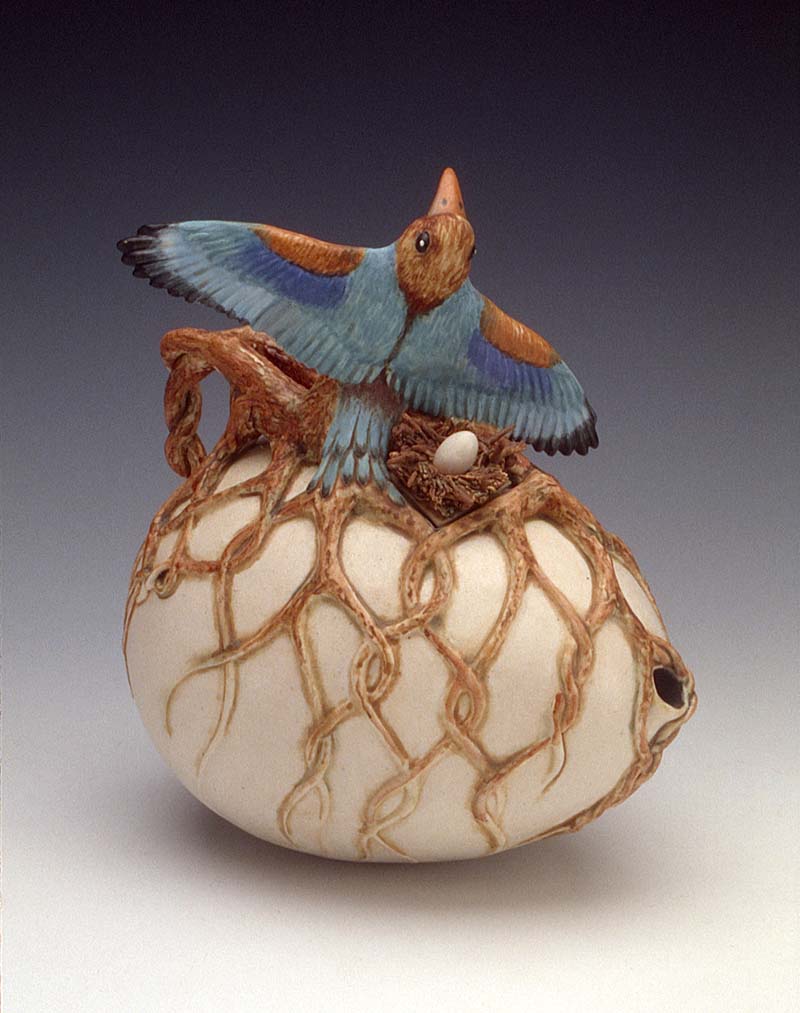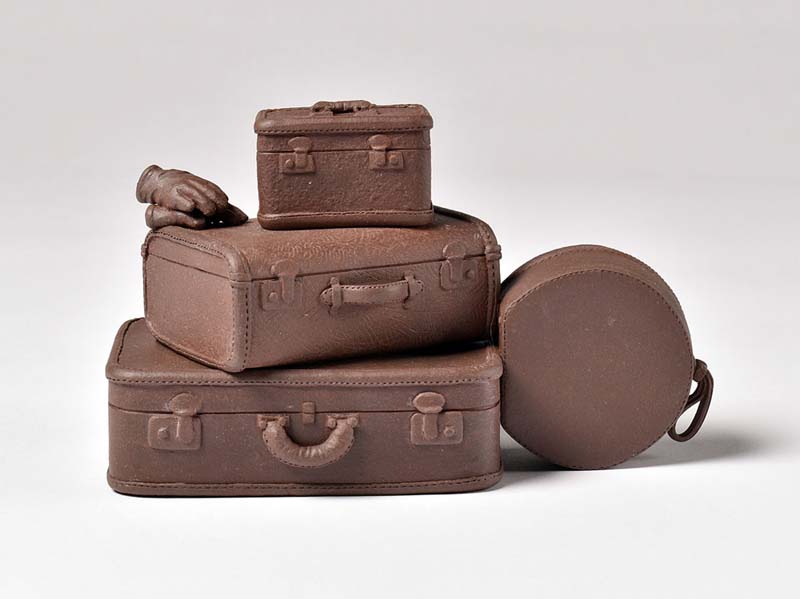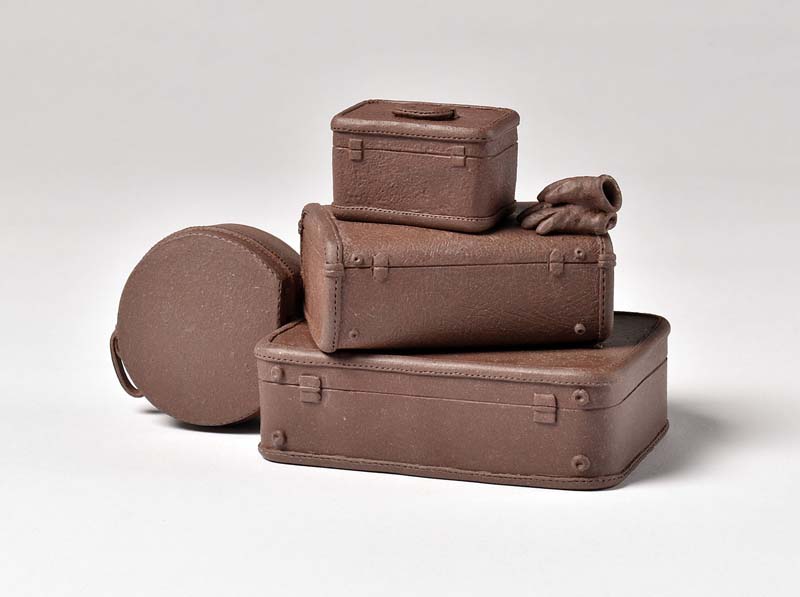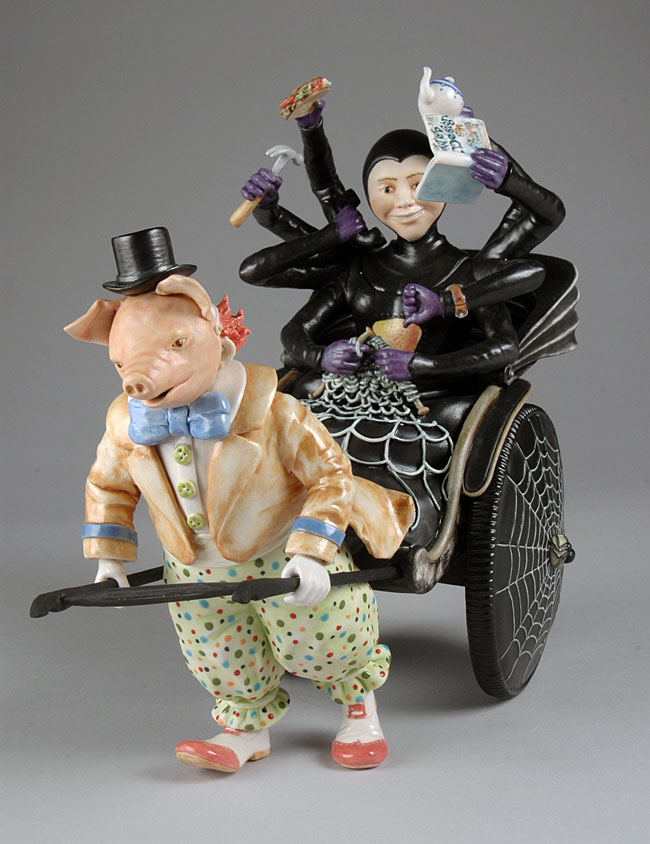“A life with clay is a meaningful life.”[i] – Kathryn McBride
The American artist Kathryn McBride (1950-2012) has been described as a “bright light” that “exuded talent” both inside and outside the studio.[ii] She had many gifts, which ranged from being a master gardener and an excellent cook to a truly inspiring teacher. However, above all, McBride lived a life “commit[ed] to clay and the creative path.”[iii] Over the course of her thirty-seven-year career, her work garnered attention, but she certainly deserves additional recognition for her contributions to the field of ceramics. She is known for her highly detailed narrative sculpture which can depict memories, journeys, and moments in time as well as the beauty of the natural world.[iv] These works are, at times, quite witty and frequently embrace the teapot form. “[McBride’s] goal [was] to share a reverence for nature, exquisite craftsmanship, and the wonder [she experienced] when [she was] fully present in the creative process.”[v]
There are five teapot sculptures by McBride in the Kamm Collection: Roots and Wings (1993), Dream Journey on the Spice Trail (c.1997), Mother’s Balancing Act: Cirque C’est La Vie Series (2003), Spider-Woman the Amazing Multitasker (2004), and Travel-Yixing (2009). They are all made of hand-built clay with a mesmerizing attention to detail, especially when you consider their size. The largest example, Dream Journey on the Spice Trail, is only sixteen inches in length. McBride, in response to the diminutive scale of her sculpture, reportedly said, “…I know I work quite small, and I’ve quit apologizing for it…”[vi]
EDUCATION
McBride attended San Francisco State University where she received a Bachelor of Arts in 1973 and a Master of Arts in 1975.[vii] Throughout the seventies the Bay area was a hotbed of activity. University campuses were “alive with debates about the Vietnam War, free speech, the civil rights movement, black, brown, and red power, and the women’s movement.”[viii] Artistically, there were burgeoning changes and Funk art was in its heyday. In essence, ceramic artists such as David Gilhooly were pushing boundaries and “blurring…the distinction between art and craft.”[ix] At San Francisco State, it was “all wide open” and the students were given complete freedom for individual expression.[x] McBride’s work during graduate school was often small in scale, explored the combination of clay and fiber, and ranged from three-dimensional landscapes to witty sculptures.[xi] For instance, one humorous example shows a scene from a hunting lodge. The animals are all relaxing and having drinks while mounted on the wall is the head of the trophy hunter.
Ceramic students at San Francisco State received a strong foundation from three influential professors: Charles (Bud) McKee, David Kuraoka, and Joe Hawley. From these individuals McBride found “encouragement,” learned how to “discipline” oneself, and gained useful “pragmatic” knowledge.[xii] McBride also received a lasting lesson in critical analysis from McKee. In essence, he had a unique way of evaluating the strength of a work. In classroom critiques McKee would often inquire, “Does it sing?”[xiii] This was the ultimate assessment. In the years to come McBride would examine her own work asking this question repeatedly.
Kathryn McBride, “Travel-Yixing” 2009. Unglazed, vitrified terra cotta, 4.13 x 7 x 3.75 in. Kamm Collection 2009.51.9. Front and back views.
VINTAGE INSPIRATIONS
McBride once stated that she was “…attracted to vintage objects from an era of quality design and craftsmanship….”[xiv] In truth she felt she was “born too late.”[xv] McBride was drawn not only to the decade of her birth, but also earlier generations, particularly the 1930s and 40s.[xvi] This fascination propelled her to collect vintage fabrics and surround herself with identifiable designs from those time periods.[xvii] At home McBride used Fiesta dinnerware, had an old Wringer washer, and sat at a chrome and Formica table. Frequently items like these would show up in her work. This is seen in a couple of the examples in the Kamm Collection. Travel-Yixing features a pile of old-fashioned luggage and a hat box. Then, in the sculpture Mother’s Balancing Act, the mother wears saddle shoes, and a hair scarf popular in the 1950s. She is surrounded by objects all from the same era, including an old ironing board, a midcentury clock, and a streamlined Electrolux vacuum.

McBride seems to embrace the simplicity or innocence of those earlier times as well. While this aesthetic could partly come from her love of children’s books, without a doubt her vintage interests had a significant influence on her stylistically. In fact, as you examine McBride’s work it is hard to not occasionally feel a “Rockwellian” vibe. Like Norman Rockwell, the scenes she creates can be “realistic with a touch of exaggeration,” playful, relatable, and tug at our nostalgic visions of the past.[xviii] With that said, it is important to note that the intimate stories she tells often relate directly to her own life. In Mother’s Balancing Act the mom is juggling an array of tasks like a performer in the circus. Here McBride is commenting on her own daily challenges as a single mom. She touches on a similar premise in the Spider-Woman the Amazing Multitasker. In this work, it is not just mothers, but women in general that are engaged in numerous tasks. The spider woman, with her eight arms, is accomplishing eight things at once from eating and pouring tea to knitting and reading a book. She sits in a black two-wheeled cart decorated with webs which is being pulled by a clown wearing a pig mask.
Kathryn McBride, “Spider-Woman the Amazing Multi-Tasker” 2004. Porcelain, 10.75 x 8.75 x 7 in. Kamm Collection 2004.111.3. Photos: Kevin O’Dwyer.
NATURE
A “reverence” for nature is also a constant theme in McBride’s work.[xix] With a conscientious attention to detail, she frequently incorporates animals and the “sensuous textures of plant-life” into her ceramics.[xx] In the Kamm Collection there are two works that reflect this interest: Dream Journey on the Spice Trail and Roots and Wings. In Dream Journey on the Spice Trail a woman rides a tiger dressed in traditional Indian clothing. She sits in a saddle holding a blue teacup and saucer surrounded by baskets of provisions. The tiger, which was inspired by the packaging of Celestial Seasonings’ Bengal Spice tea, is especially detailed.[xxi] Each stripe is carefully painted and McBride even captures the texture of the animal’s hairy coat. In the other work, Roots and Dreams, a blue bird with its wings outstretched appears to be taking flight from its nest. The nest, which holds a single egg, rests upon a larger egg covered in roots. This arrangement feels very emblematic. In some cultures, the bluebird is a symbol of love and renewal and “dreaming of bluebirds often represents happiness, joy, fulfillment, hope, prosperity, and good luck.”[xxii] Furthermore, the inclusion of the eggs and roots introduce notions of perhaps fertility and permanence. For McBride, “meaning was found in very old places and times” and it is hard to not see her embracing symbolism such as this.[xxiii]

TEACHING
In talking to friends and colleagues of McBride, an emphasis was consistently put on her generous spirit. She was a gift giver. It seems it was not uncommon for her to stay up all night making something for someone. This is the same quality which certainly made McBride an excellent teacher. After she completed her master’s degree, McBride began teaching, primarily in the San Francisco Bay area. However, around 2002 she was appointed to Cabrillo College in Aptos, California. McBride worked at Cabrillo, as an instructor and then head of the ceramics department, until her death. She seemed to have that innate ability to inspire. It did not matter if it was during a classroom slide show or a collaborative project, if it was with children in her home studio or young adults on a college campus, she was a “natural teacher,” and her impact was far reaching.[xxiv] Many former pupils have expressed their appreciation for her dedication, her contagious energy, her spellbinding way of leading by example, and her ability to share her comprehensive knowledge of the material she loved. One touching tribute stated that “from McBride, [she] witnessed and learned that the art of creating was not so much about having great inspiration or wielding exceptional skills.”[xxv] Instead, “it was about being present, having patience, and loving the process.”[xxvi]
A special thank you to Gail Ritchie and Liz Crain for their willingness to share their memories of Kathryn McBride.
Further Reading/Viewing:
Ferrin, Leslie. Teapots Transformed: Exploration of an Object. Madison, WI: GUILD Publishing, 2000.
George Orbelian’s Website (A Friend of McBride’s. He features numerous examples of her work on his website.)
Gunter, Veronika Alice. 500 Figures: Ceramic Artists Celebrate the Human Form. Vol.1. New York, NY: Lark Books, 2004.
Tourtillott, Suzanne J. E. 500 Teapots: Contemporary Explorations of a Timeless Design. Vol.1. New York, NY: Lark Books, 2002.
Notes:





